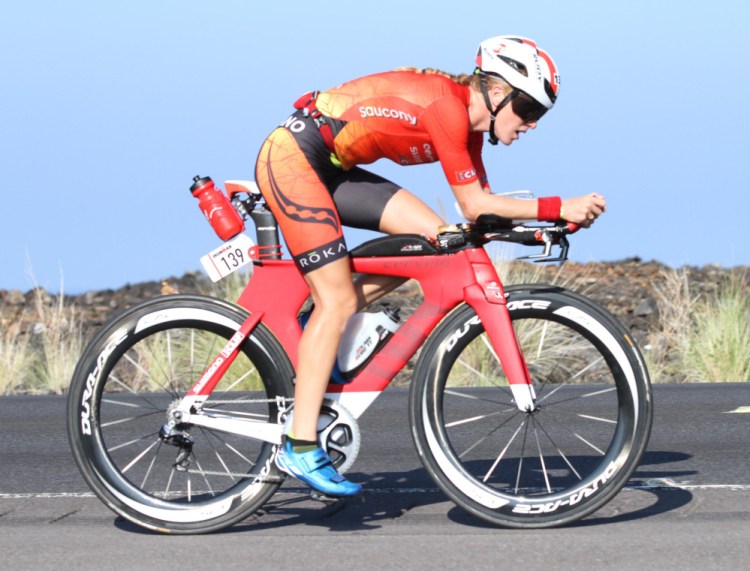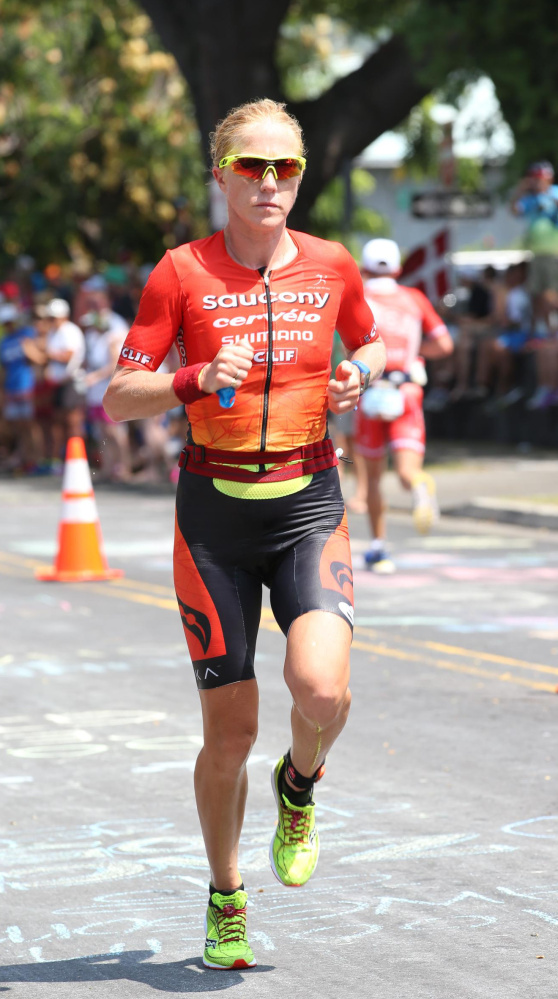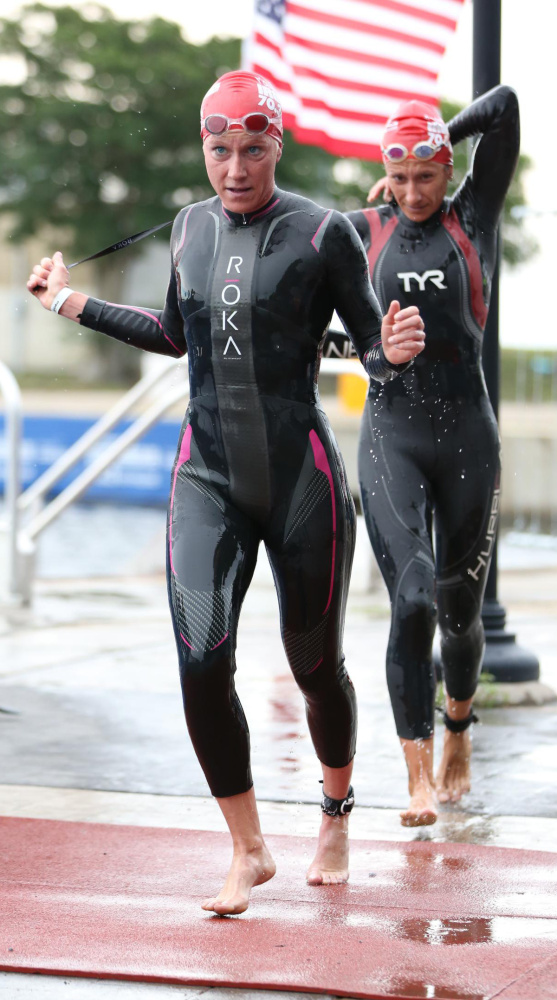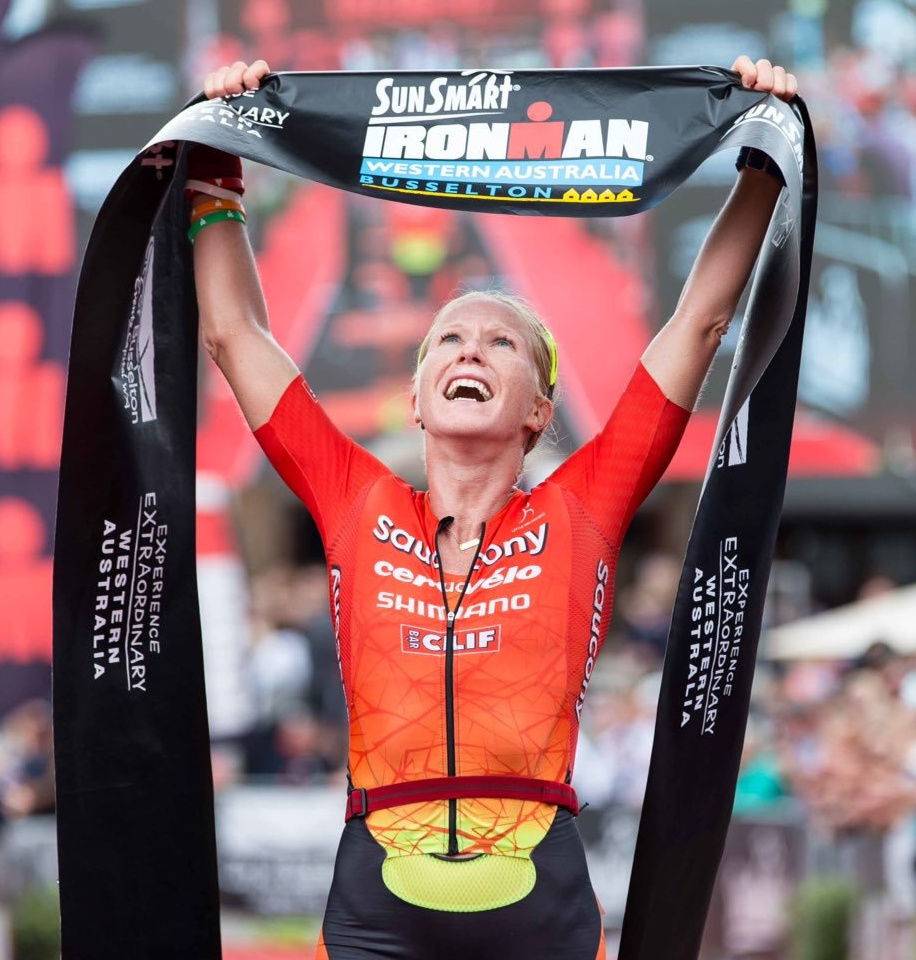Sarah Piampiano held a vodka tonic in one hand and a smoldering Parliament Light in the other. She was in a Manhattan bar with a college friend who had put on weight since they were students at Colby College.
He mentioned that he had registered for a triathlon in New Hampshire.
“I’ll do it with you,” she said. “I bet I could beat you.”
“You can’t beat me,” he replied. “You’re chain-smoking and you don’t even work out.”
A month later they raced. After staying close through the swim and bike portions, Piampiano pulled ahead on the run to win the bet by more than 20 minutes.
She was hooked.
“I was extremely inspired by the sense of community, of all the people who were doing something healthy for themselves,” she said. “Young people, older people, overweight people. They were all coming together. It was exactly what I needed to make a change in my life.”
Now, more than six years later, Piampiano has ditched cigarettes, booze and a high-pressure job in finance to move to California and become a professional triathlete.
In October, she finished seventh in the Ironman world championships in Kona, Hawaii. Earlier this month in Western Australia, she won her first professional full-distance Ironman, featuring a 2.4-mile ocean swim, 112-mile bike ride and 26.2-mile marathon.
She completed it in a little more than nine hours. To put such a challenge in perspective, imagine swimming Peaks Island to shore in Portland, pedaling a bike to Boston, then running the Boston Marathon route in reverse to Hopkinton.
“If you had asked me back in 2007 or 2008, where would I be,” said Piampiano, 35, “I would never have said I’d be traveling around the world competing as a professional athlete.”
And yet, way back in elementary school in Cumberland, Piampiano had dreamed of winning Olympic medals. She wrote reports on Joan Benoit Samuelson. In fifth grade she even sent Samuelson a letter, and was delighted to receive a handwritten reply from the Olympic marathon champion.
“When I was growing up,” Piampiano said, “she was my idol.”
AN UNHEALTHY CULTURE
Like Samuelson, Piampiano developed a talent not only for running but for downhill ski racing. She had two older brothers and parents who encouraged reading and outdoor activities.
“We were one of those unusual families that did not have a television,” said Brenda Piampiano, 67, who recently moved from Cumberland to Brunswick with her husband, Robert, 70. “My oldest son was 13 or 14 before we got one, and we didn’t buy it. A person who worked for us thought we couldn’t afford one and she surprised us.”
As a Greely High sophomore, Sarah won the 1995 Class B cross country state title. She spent her junior and senior years at Stratton Mountain School in Vermont, and competed in both cross country and skiing at Colby.
Upon graduation in 2002 with a double major in biology and economics, she moved to San Francisco to join the world of investment banking with its long hours, cut-throat competition and male-centric culture. In 2005, she advanced to Wall Street and continued to climb the corporate ladder.
“I started smoking when I moved to New York,” she said. “A big part of that was job-related.”
She often slept under her desk with her Blackberry clutched to her chest. Her specialty was mergers and acquisitions, focusing on U.S.-based companies expanding into Asia.
“So there were a lot of conference calls at 1 or 2 in the morning,” she said. “You had to be (available) on a 24-hour basis.”
Such a culture frowned upon the desire to leave work to go for a stroll around the block. But a smoking break? Go for it. For Piampiano, an occasional drag became a full cigarette and eventually turned a former athlete into a smoker.
“The whole thing manifested from wanting to have a moment for yourself aside from sitting at a desk staring at a computer,” she said. “As I progressed, the amount of time I spent in the office decreased but my time on the road increased.”
One year she spent eight weeks in China, flew home for three days, returned to China until Dec. 23 and flew back to China five days later. Of course there were perks. She traveled the world, earned a big salary and saved enough to buy an apartment.
But that triathlon in New Hampshire rekindled an old competitive flame. On the ride back to New York she pored over a triathlon magazine, reading articles and checking results. She bought a bike, and for the first time in five years, new running shoes.
MAKING THE LEAP
Piampiano still worked crazy hours but now found time to squeeze in an hour a day for training. She and her bar-bet buddy, Todd Elmer, signed up for an Olympic-distance triathlon in Florida that fall.
“I ended up winning as overall amateur,” Piampiano said. “After that happened, Todd was like, ‘You should go pro. You have a lot of potential.’ I think that’s where I made the switch. I went from being a participant to being a competitor.”
Suddenly her childhood dreams of Olympic glory seemed within reach. But it wasn’t long before she realized the Olympic distance of a 1.5-kilometer swim, 40K bike ride and 10K run simply wasn’t long enough to suit her talents.
“As it turned out,” she said, “I’m not a strong enough swimmer to race the style of triathlon that’s in the Olympics.”
Oh, but she could grind. She hired a coach, and the following year went to her employer, HSBC, and spoke of her desire to test the pro triathlon waters. The bank agreed to reduce her workload to four 10-hour days, eliminate travel and didn’t expect her to answer emails immediately when out of the office.
The following year, 2011, Piampiano was the first overall amateur in four major Ironman races. She finished as the top American amateur – fifth overall – at the Ironman world championships in Kona.
That November she turned pro.
Her mother wasn’t pleased.
“I begged her to just continue as an amateur or continue working,” Brenda Piampiano said. “If you look at the statistics, lots and lots of people try this and very few succeed. But she was determined to throw her whole self into it.”
Piampiano left her job, her big paycheck and New York to train full time. A prominent open-water swim coach, Gerry Rodrigues, lived in California, so at the age of 31, Piampiano moved to Los Angeles.
“It was really scary,” she said. “Having a business background helped. I was able to secure a number of endorsements with some great companies. But I wasn’t getting paid, really. There was a lot of product stuff, but my income was virtually nonexistent.”
She relied on savings and frugal budgeting her first two years as a pro. One of her first sponsors, the Saucony shoe company, also sponsors another Greely High grad, distance runner and Olympic hopeful Ben True. True’s wife, the former Sarah Groff, already has qualified for the Rio de Janeiro Olympics as a triathlete; she swam competitively at Middlebury College in Vermont.
A MAJOR INJURY
Piampiano’s third race as a pro was a half Ironman in New Orleans, and among the field was the 2010 world champion, Australian Mirinda Carfrae, who would go on to repeat as world champ in 2013 and 2014. Because of high winds, the swim portion in Lake Ponchatrain was replaced by a 2-mile run. With her weakest event eliminated, Piampiano won the race, with Carfrae third.
“When I won, nobody knew who I was,” Piampiano said. “After that, from a performance perspective, I struggled a bit.”
She was the only first-year pro who qualified for the world championships in Kona, where she finished second to last. In 2013, she didn’t win but found herself on the podium more often. She qualified for the world event but declined the spot, knowing she wouldn’t be in contention for the top 10.
After making significant gains in her biking and running in 2014, Piampiano started having issues with her left leg leading up to the North American Ironman championships in Texas.
An MRI was inconclusive. It didn’t seem to be a stress fracture. For more than a month, she didn’t run. The morning of the race, she couldn’t even run her typical minute-long warm-up.
Still, she persisted. At Mile 24, the leg shut down. It would not drive forward. So she swung it around and hobbled the final two miles.
Turned out her femur was broken. It was September before she could resume training. Her first race back was in Western Australia last winter.
“I have never been more nervous for a race than that one,” she said. “They assured me it was healed, but I was still in a lot of pain and I had put on about 20 pounds.”
She finished eighth in 9 hours, 12 minutes, 38 seconds, with a marathon time just under 3:15.
“Looking back on it now, it was a pretty darn good result given the state I was in,” she said.
She won no prize money, same as for the previous seven months, while still paying for physical therapists and medical folks, and coaching and pool and gym fees.
THE ROUSING COMEBACK
Piampiano wondered if she could actually make a living as a professional athlete. She said she had to dip into savings and incur debt to make ends meet during her first three years as a pro. Sponsors “essentially said we’ll stick with you for one more year but we need to see results.”
So there was plenty of pressure coming into 2015. Piampiano responded.
She placed sixth in South Africa in January, second in Mexico and eighth in California in March. She returned to New Orleans in April and set a course record. At the full-distance North American championships in May, she placed sixth, then followed with a pair of third-place finishes in Maryland (a half, or 70.3 miles) and in Austria (a full) in June.
On her way back from Europe, she stopped in Maine and hopped into the LL Bean Fourth of July 10K, after which a mutual friend introduced her to Samuelson.
“She’s such a lovely person,” Piampiano said. “She’s a very strong female and great person to inspire others.”
The next big test was the world championships in Kona in October. The top 35 women, according to world rankings, qualify. Piampiano squeezed in at 33.
Six other women had automatic entries from success in previous years, raising the professional field to 41. Piampiano came out of the water ahead of just one other woman. In the bike leg, she moved up to 17th. She ran her way up to seventh.
The victory in early December in Western Australia was her biggest payday as a triathlete: $10,000 for finishing first and another $25,000 in performance bonuses. The win bumped her world ranking to sixth and guaranteed her a spot for Kona in 2016.
“In Kona, there were only two women under 30 and three or four over the age of 40, so I feel like I’m right in my prime,” she said. “I feel like I’ve got another five years and I’ve got some big goals.”
Last year, she moved to San Francisco to work more closely with her coach, Matt Dixon of Purplepatch Fitness. She is dating a sports chiropractor who did his first triathlon this year.
Her mother has made peace with her daughter’s decision but still worries about the risk of injury or burnout.
“But the good point is that you’re paid by your sponsors or your race winnings to travel all over the world to pursue your dreams,” Brenda Piampiano said. “She can work in offices later. This is her one chance to test herself as an athlete and that’s what she’s chosen to do.”
Send questions/comments to the editors.







Success. Please wait for the page to reload. If the page does not reload within 5 seconds, please refresh the page.
Enter your email and password to access comments.
Hi, to comment on stories you must . This profile is in addition to your subscription and website login.
Already have a commenting profile? .
Invalid username/password.
Please check your email to confirm and complete your registration.
Only subscribers are eligible to post comments. Please subscribe or login first for digital access. Here’s why.
Use the form below to reset your password. When you've submitted your account email, we will send an email with a reset code.